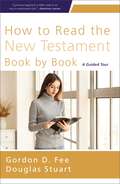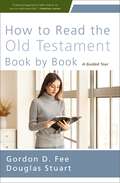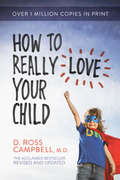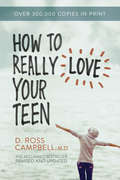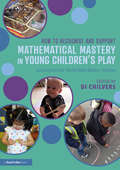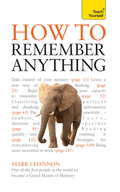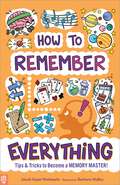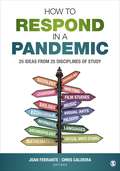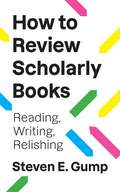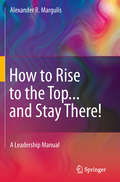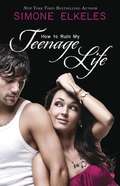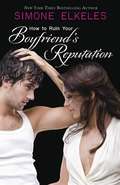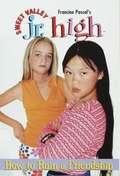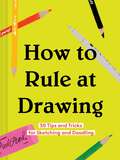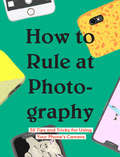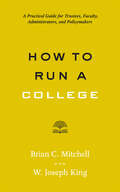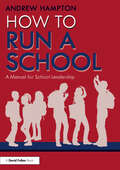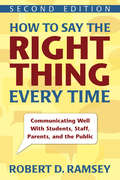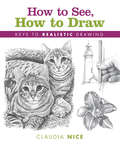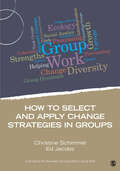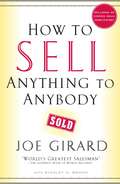- Table View
- List View
How to Read the Bible: A Simple Guide to Deeper Intimacy with God
by David PlattThis simple and practical guide to studying and understanding Scripture will help you see the Bible as a priceless treasure that reveals God's love for you and His relentless pursuit of a deeper relationship.How to Read the Bible is not just a book; it's an invitation to experience God's Word in a way that transforms your life. Whether you're new to reading the Bible or seeking a fresh approach to study and apply it, this guide provides the tools and insights you need to explore Scripture with greater clarity and purpose.David Platt, author of the bestseller Radical and host of Secret Church (an annual event streamed to participants around the world), shows you how to read, study, and understand the Bible in such a way that you fall deeper in love with its Author. His four-step guide to studying God's Word rightly is set up with the acrostic MAPS:Meditate on and memorize God's Word, storing it in your heart and mind so that you walk closer with Jesus each day.Apply the Bible's truths to every layer of your life, allowing the Holy Spirit to transform you and revolutionize your ultimate purpose for living.Pray boldly, confident that God will answer and align your heart with His Word.Share God's Word with others, letting it flow through you to your neighbor as well as to others around the world. Each chapter includes interactive questions for self-reflection or group discussion, and an appendix that offers practical tips for reading different parts of the Bible (Law, Poetry, Gospels, Revelation, etc.).As you dive into the richness of the Bible using this proven, step-by-step approach, you will learn to avoid common pitfalls in interpretation, savor scriptures through meditation and prayer, and apply timeless truths to every area of your life. How to Read the Bible equips you to better understand not only the Word of God but also the love of God and His plan for the world.
How to Read the New Testament Book by Book: A Guided Tour
by Douglas Stuart Gordon D. FeeReading the New Testament doesn't need to be a difficult journey through strange and bewildering territory. How to Read the New Testament Book by Book walks you through the Scriptures like an experienced tour guide, helping you understand each of its twenty-seven books.For each book of the New Testament, the authors start with a quick snapshot, then expand the view to help you better understand its message and how it fits into the grand narrative of the Bible. Written by two top evangelical scholars, this survey is designed to get you actually reading the Bible knowledgeably and understanding it accurately.In an engaging, conversational style, Gordon Fee and Douglas Stuart take you through every book of the Old Testament using their unique approach:Orienting Data - Concise info bytes that form a thumbnail of the book.Overview - A brief panorama that introduces key concepts and themes and important landmarks in the book.Specific Advice for Reading - Pointers for accurately understanding the details and message of the book in context with the circumstances surrounding its writing.A Walk Through - The actual section-by-section tour that helps you see both the larger landscape of the book and how its various parts work together to form the whole.How to Read the New Testament Book by Book can be used as a companion to How to Read the Old Testament Book by Book and How to Read the Bible for All Its Worth. It also stands on its own as a reliable guide to reading and understanding the New Testament for yourself.
How to Read the Old Testament Book by Book: A Guided Tour
by Douglas Stuart Gordon D. FeeReading the Old Testament doesn't need to be a difficult journey through strange and bewildering territory. How to Read the Old Testament Book by Book walks you through the Scriptures like an experienced tour guide, helping you understand each of its thirty-nine books.For each book of the Old Testament, the authors start with a quick snapshot, then expand the view to help you better understand its message and how it fits into the grand narrative of the Bible. Written by two top evangelical scholars, this survey is designed to get you actually reading the Bible knowledgeably and understanding it accurately.In an engaging, conversational style, Gordon Fee and Douglas Stuart take you through every book of the Old Testament using their unique approach:Orienting Data - Concise info bytes that form a thumbnail of the book.Overview - A brief panorama that introduces key concepts and themes and important landmarks in the book.Specific Advice for Reading - Pointers for accurately understanding the details and message of the book in context with the circumstances surrounding its writing.A Walk Through - The actual section-by-section tour that helps you see both the larger landscape of the book and how its various parts work together to form the whole.How to Read the Old Testament Book by Book can be used as a companion to How to Read the New Testament Book by Book and How to Read the Bible for All Its Worth. It also stands on its own as a reliable guide to reading and understanding the Old Testament for yourself.
How to Really Love Your Child
by D. Ross CampbellMany parents would be dismayed to discover that their child feels unloved. After all, they make sure that their child has the things they need. They attend their child's school events. They buy their child the things they want. So why is it then that most children doubt that they are genuinely and unconditionally loved? In this best-selling book, Dr. D. Ross Campbell reveals the emotional needs of a child and provides parents with the skill and techniques that can begin to help make your child feel truly loved and accepted. You'll learn to really love your child through every situation of child rearing from physical touch to discipline and from affirmation to spiritual nurture.
How to Really Love Your Teen
by D. Ross CampbellIt's one of the most common parenting scenarios--parent and child are developing nicely, when the child crosses that mysterious threshold into the "teenager zone." Suddenly, the parents feel unable to fully relate to their teen--and the teen responds to the parents' uneasiness. In this best-selling book, Dr. Campbell helps parents understanding the delicate dance between parents and their emerging teenagers. Learn how to create a solid, balanced approach for relating to your teen, how to communicate unconditional love, how to handle teenage anger, as well as your own, and how to help your teenager grow spiritually and intellectually.
How to Recognise and Support Mathematical Mastery in Young Children’s Play: Learning from the 'Talk for Maths Mastery' Initiative
by Di ChilversThis exciting book explores young children’s fascination with all things mathematical. Drawing on the 'Talk for Maths Mastery' initiative, it helps practitioners to understand early mathematical development and recognise the maths taking place in children’s play. Emphasising the importance of starting from children’s existing mathematical interests, it shows how adults can build on these starting points to gradually introduce new concepts and address misconceptions as they arise. The book considers how mathematical development and learning is embedded within children’s dispositions and mindsets. Including case studies, links to practice and reflective questions, the chapters reveal what mastery orientation looks like from the children’s perspective in their learning and covers: children’s serve and return conversational talk mathematical babies and their developmental momentum schematic patterns of thinking mathematical mark-making child-led play problem solving creative and critical thinking how adults can support children’s mathematical talk, thinking and mastery Featuring children’s learning stories and full-colour photographs throughout to illustrate practice, this book is essential reading for all early years practitioners and teachers working with children throughout the EYFS and KS1 as well as students on early years courses.
How to Recruit and Retain Higher Education Students: A Handbook of Good Practice
by Tony Cook Brian S. RushtonHow to Recruit and Retain Higher Education Students is an invaluable resource for academic staff, administrators and policy makers involved in student recruitment and improving student retention. It offers practical advice on how universities can influence the expectations of prospective students, allowing them to make sensible decisions about careers, courses and institutions. Many surveys of students who drop out of university show that most do so out of disappointment. Failing to understand what higher education was about quickly enough, they become confused and frustrated. Dropping out seems the best solution. This book describes a series of practices proven to encourage students to stay on, discussing the background research on student attrition. By preparing students better for their higher education experience, the practices in this book are effective not only in recruiting students but also in matching them to the right institutions and programmes. The practices described range from those reaching out in a broad way to communities of potential students, to university support for pre-entry examinations, to enhanced communication between institutions and applicants. All are described in sufficient detail to allow judgments to be made about how to use and adapt them to suit local needs. How to Recruit and Retain Higher Education Students provides a sound theoretical foundation for research into student retention and provides the necessary underpinning for those academic staff embarking on courses and assists in preparing them for their roles in both teaching and student support.
How to Remember Anything: Teach Yourself
by Mark ChannonWhat would you do if you could remember anything? ""How to Remember Anything"" shows how a radically improved memory can add real value in life and in business and can help build your career and your personal life. It is full of practical techniques that will not just show you how to remember things such as numbers, dates and facts, but also real and innovative insight into new ways of learning and processing information that could completely change your life. The goal of this book is to show you how to use your new, improved memory to enhance your career, your personal life and your leisure time, and because of this it is more practical and transformational than any other 'Memory boosting' title available.
How to Remember Everything: Tips & Tricks to Become a Memory Master!
by Jacob Sager Weinstein Odd DotHOW TO REMEMBER EVERYTHING is the ultimate guide to unlocking the power of your brain!Kids will learn how to ace history tests by memorizing dates, feel confident about remembering people's names, win card games by mastering entire decks, and hang on to happy memories for a lifetime.This invaluable memory guide for children is full of recall-building techniques, fun challenges, and hilarious art.
How to Respond in a Pandemic: 25 Ideas from 25 Disciplines of Study
by Joan Ferrante Chris CaldeiraHow can an undergraduate college education prepare learners to cope with the current COVID-19 pandemic? This collection of short essays, written by experts in 25 academic fields of study, addresses this very question. Each chapter brings perspective and insight from that discipline, presenting one useful idea and a recommended course of action. This one-of-a-kind resource is ideal for students, instructors, and administrators, particularly during the 2020-2021-academic year when institutions are challenged to continue their educational missions in the midst of a public health crisis that affects every aspect of college life.
How to Respond in a Pandemic: 25 Ideas from 25 Disciplines of Study
by Joan Ferrante Chris CaldeiraHow can an undergraduate college education prepare learners to cope with the current COVID-19 pandemic? This collection of short essays, written by experts in 25 academic fields of study, addresses this very question. Each chapter brings perspective and insight from that discipline, presenting one useful idea and a recommended course of action. This one-of-a-kind resource is ideal for students, instructors, and administrators, particularly during the 2020-2021-academic year when institutions are challenged to continue their educational missions in the midst of a public health crisis that affects every aspect of college life.
How to Review Scholarly Books: Reading, Writing, Relishing (Skills for Scholars)
by Steven E. GumpA guide to the art of reviewing scholarly books, with strategies and suggestionsScholarly book reviews should be enjoyable—both to write and to read. All too often, though, they offer little more than chapter-by-chapter summaries. In this comprehensive handbook, Steven Gump offers an encouraging guide to crafting valuable reviews of scholarly books in the humanities and social sciences. Readers learn how to write engaging, respectful reviews that make intellectual contributions of their own. With extensive experience in both writing and editing scholarly book reviews, Gump walks prospective reviewers through the process of selecting a book to review, identifying a venue to publish the review, reading and annotating the book, and writing a review that is tailored to the audience of the target venue, with the possibility of dissemination to popular outlets beyond the core field.Alongside this practical advice, Gump offers a generous philosophy of scholarly book reviewing that considers the roles of book reviews and the responsibilities of book reviewers within the broader scholarly ecosystem. Readers learn how to uplift the voices and contributions of authors, how to prepare the next generation of reviewers (including undergraduates or graduate students), and how to elevate an unjustly underestimated genre. Ultimately, this essential guide brings into renewed focus the joys of reading scholarly works, engaging with intellectual ideas, and writing incisively.
How to Rise to the Top...and Stay There!
by Alexander R. MargulisThe present dire economic environment has greatly affected business and the opportunities for advancement or even holding a job. Even universities, although not directly in business, are feeling the impact of diminishing endowments, resulting in lower disposable funds and reduction in innovative, unproven programs, which, in the past, often led to breakthroughs. These conditions we hope are only temporary, and they will not affect careers in the long run. This book is written to guide the reader on how to progress in his or her chosen career, how to reach a high position in which one is actually in charge of a unit, department, school, or business and how to run it successfully.
How to Ruin My Teenage Life (How to Ruin #2)
by Simone ElkelesIn this sequel to "How to Ruin a Summer Vacation", everything in 16-year-old Amy Nelson-Barak's life is going wrong. What's a girl to do when everyone is trying to ruin her life?
How to Ruin Your Boyfriend's Reputation (How to Ruin #3)
by Simone ElkelesIn the third book of this bestselling series, Amy Barak-Nelson misses her boyfriend Avi, who is in the Israeli army. Her grandmother convinces Amy to sign up for two weeks in a military training base. Not her idea of fun, but what's worse?
How to Ruin a Friendship (Sweet Valley Junior High #7)
by Jamie Suzanne Francine PascalElizabeth and Salvador share a secret kiss.... Why oh why oh WHY did Elizabeth ever kiss Salvador? No way can they tell Anna what happened. Especially now. She's having such a hard time with the anniversary of her brother's death coming up and all. This whole thing is turning into the biggest mess. But they really should tell Anna. Shouldn't they?
How to Ruin a Summer Vacation (How to Ruin #1)
by Simone ElkelesAmy is a spoiled American teenager with an attitude to match her Jimmy Choo slides. When her estranged father drags her to Israel to meet a family she's never known, one hilarious humiliation after another tests Amy's fierce spirit.
How to Rule at Drawing: 50 Tips and Tricks for Sketching and Doodling
by Chronicle BooksHow to Rule at Drawing features 50 bite-size tips and tricks to help you improve your art skills. This easy-to-follow, irresistibly illustrated book will get you in the habit of capturing not just what you see, but also what you feel.Whether you're a beginner just learning the basics or an expert looking to hone your skills, this handbook is the perfect easy-breezy volume for anyone who wants to up their art-making game. The simple and actionable takeaways will help readers take their sketching skills to new heights. • Filled with irresistible illustrations from artist Rachel Harrell• Accessible to beginners but still useful for the advanced artist • Easy-to-follow instructional content In How to Rule at Drawing, budding artists will discover new ways to warm up, master new tools and techniques, and make good art. Part of the How to Rule series, a collection of tiny how-to books you can take anywhere to improve your creative skills.• A perfect gift for aspiring and hobbyist artists, art students, burgeoning creatives, sketchers, doodlers, and mark-makers of all sorts• Makes drawing easy, approachable, and super fun• Great for readers and artists who enjoyed How to Draw What You See by Ruby De Reyna, Drawing for the Absolute Beginner: A Clear & Easy Guide to Successful Drawing by Mark Willenbrink, and Draw the Draw 50 Way by Lee J. Ames
How to Rule at Photography: 50 Tips and Tricks for Using Your Phone's Camera
by Chronicle BooksHow to Rule at Photography features 50 bite-size tips and tricks to help you improve your photo skills with your phone's camera. Creating brilliant photos with your phone isn't as hard as you might think, and the easy-to-follow advice in this book goes way beyond selfie help. Let these deceptively simple tips help you unleash your inner creativity and upgrade your social media feed as you start snapping great shots using only your phone. You'll not only learn actionable tips to make your photos better—you'll learn how to develop your own personal style along the way.• Simple and effective instructional content• Features tips for amateur documentarians and aspiring social media influencers• Advice on how to pose for a portrait, get the best lighting, and edit images like a pro using nothing but your smartphoneThis book is the perfect easy-breezy volume for the person who wants to up their phone photography game. Part of the How to Rule series, a collection of concise how-to books you can take anywhere to improve your creative skills.• Perfect for aspiring and hobbyist photographers, art students, Instagram addicts, and selfie takers• Makes smartphone photography easy, approachable, and super fun• Great for readers who enjoyed How to Create Stunning Digital Photography by Tony Northrup, The Beginner's Photography Guide by Chris Gatcum, and BetterPhoto Basics by Jim Miotke
How to Run a College: A Practical Guide for Trustees, Faculty, Administrators, and Policymakers (Higher Ed Leadership Essentials)
by Brian C. Mitchell W. Joseph KingHow can colleges stay relevant in the twenty-first century?Residential colleges are the foundation on which US higher education is based. These institutions possess storied traditions fondly cherished by students, alumni, and faculty. There is no denying, however, that all colleges today struggle with changing consumer preferences, high sticker prices, and aging infrastructure. Technological and pedagogical alternatives—not to mention growing political pressure—present complex challenges. What can colleges and smaller universities do to stay relevant in today’s educational and economic climate? In their concise guide, How to Run a College, Brian C. Mitchell and W. Joseph King analyze how colleges operate. Widely experienced as trustees, administrators, and faculty, they understand that colleges must update their practices, monetize their assets, and focus on core educational strategies in order to build strong institutions.Mitchell and King offer a frank yet optimistic vision for how colleges can change without losing their fundamental strengths. To survive and become sustainable, they must be centers of dynamic learning, as well as economic engines able to power regional, state, and national economies. Rejecting the notion that American colleges are holdovers from a bygone time, How to Run a College shows instead that they are centers of experimentation and innovation that heavily influence higher education not only in the United States but also worldwide.
How to Run a School: A Manual for School Leadership
by Andrew HamptonHeadteachers need to have a view on every possible aspect of running a school and be able to justify and articulate a set of values that tie into their vision. This essential text considers every aspect of leading a school, from the technical to the visionary, enabling you to support the best holistic educational outcomes for children.Written by experienced Headteacher and best-selling author, Andrew Hampton, the book examines school leadership from four angles – how to lead pupils, staff, parents and Governors. Full of practical strategies to help readers respond to the challenges and dilemmas of running a school, the chapters provide valuable insights into key topics such as inspection, behaviour, curriculum, crisis management, safeguarding, budgeting, and parent partnerships. Throughout, there is a focus on building personal and professional resilience and ways to become emotionally robust.Written for new and aspirant Headteachers across the primary and secondary phases, as well as experienced Heads looking for fresh solutions, How to Run a School will enable you to hone your vision and values and project your leadership with certainty and authenticity.
How to Say the Right Thing Every Time: Communicating Well With Students, Staff, Parents, and the Public
by Robert D. RamseyCommunicate effectively with all stakeholders through these invaluable tips, including how-to's for dealing with disasters and approaching sensitive topics such as sex, gangs, and substance abuse.
How to See, How to Draw: Keys to Realistic Drawing
by Claudia NiceImagine having the ability to draw any subject with precision, detail and expression. With Claudia's help, you can do it! In How to See, How to Draw, you will discover how to tap into your powers of observation, strengthen your hand-eye connection, and draw the world around you with new skill and accuracy. Just take it one step at a time. Claudia is an expert teacher, breaking down complex compositions into a series of achievable shapes and values that even beginners will understand. Through dozens of mini demonstrations, fun-to-do exercises and complete step-by-step instruction, you'll learn everything from basic drawing techniques to more challenging methods for rendering wonderfully rich, in-depth compositions. Her visual instruction details how to: Use a variety of drawing tools to suit your style and artistic intent Learn to let go of preconceived ideas so you can observe lines, shapes and spatial relationships as they actually are Create strong compositions through comparison and proportional control Find, fix and avoid common mistakes by using simple grids and guide lines Understand and work with perspective to create the illusion of depth Reveal form through light and shadow Explore the potential of texture to create mood and movement Claudia's drawings illuminate a range of subjects, including portraits, landscapes, animals and still life. You can practice using her reference photos and drawings, or you can apply her exercises to your own subjects. Start today, Claudia's way! Following her masterful guidance, you'll see the world through new eyes and draw better than you ever have before.
How to Select and Apply Change Strategies in Groups (Group Work Practice Kit)
by Christine Schimmel Ed JacobsLearn to develop key strategies and directly influence positive group culture This accessible book details the competencies, functions, and strategies that help members benefit from a positive group culture as they pursue their own learning. The authors demonstrate how group members and leaders learn and derive meaning from their group work experience. Drawing on the latest research on group work, this practical book also covers diversity and multicultural issues as well as accreditation or specialty standards. How to Select and Apply Change Strategies in Groups is part of the Group Work Practice Kit: Improving the Everyday Practice of Group Work, a collection of nine books each authored by scholars in the specific field of group work. To promote a consistent reading experience, the books in the collection conform to editor Robert K. Conyne’s outline. Designed to provide practitioners, instructors, students, and trainees with concrete direction for improving group work, the series provides thorough coverage of the entire span of group work practice. This book is endorsed by the Association for Specialists in Group Work.
How to Sell Anything to Anybody
by Joe Girard Stanley H. Brown"Salesmen are made, not born. If I did it, you can do it." -- Joe Girard In his fifteen-year selling career, author Joe Girard sold 13,001 cars, a Guinness World Record. He didn't have a degree from an Ivy League school -- instead, he learned by being in the trenches every day that nothing replaces old-fashioned salesmanship. He insists that by building on basic principles of trust and hard work, anyone can do what he did. This bestselling classic has helped millions of readers meet their goals -- and you will too. Joe will show you how to make the final sale every time, using the techniques he has perfected in his record career. You too can: TURN ONE SALE INTO 250 MORE CREATE A WINNING GAME PLAN FROM LOSING SALES KNOW THE FIVE WAYS TO TURN A PROSPECT INTO A BUYER MOVE PAST THE CUSTOMER'S LAST HURDLE TO CLOSE THE SALE SELL AT A LOSS AND MAKE A FURTUNE

